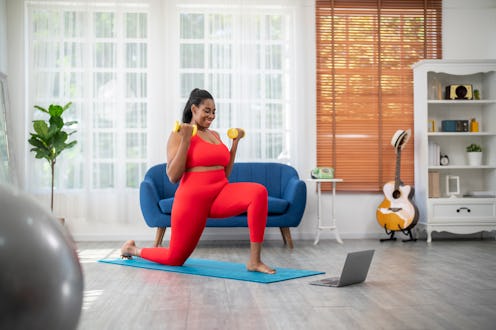Fitness
Why Push & Pull Exercises Are Key For Functional Strength
Here's the deal.

You don’t realize it, but the average day includes a lot of pulling and pushing. You pull open doors, push yourself up out of chairs, pull heavy bags over your shoulder — and so on as you go about your routine. That’s why doing exercises that specifically target your pull and push muscles can be so beneficial.
In fact, push and pull exercises are some of the most functional movements you can do thanks to the way they help you out in everyday life, says Bethany Stillwaggon, ACSM-CPT, a certified personal trainer and master coach for Row House. Push exercises replicate things like getting in and out of a car, squatting at the grocery store to grab an item, or putting a book back on a high shelf, Stillwaggon tells Bustle. All of these motions require you to push up, off, or away from your body.
A pull exercise is the opposite of that, and it’s equally present in your day-to-day life. “Pull exercises involve bringing something closer to your body with flexion of the muscles involved,” Stillwaggon says. And that’s helpful for things like pulling a heavy box towards you, picking something up, and yanking open stuck doors.
To make sure you’re working your push and pull muscles equally — and maintaining balance within the body — you can actually break up your workouts into “push days” and “pull days” with a few rest days in between, says Alayna Curry, an AFAA-certified fitness instructor. “One major benefit of training with push/pull days is that you’re able to be more efficient with your workouts and it allows for proper recovery time,” she notes.
Here’s what you need to know about push versus pull exercises, plus some examples of each.
Push Exercises
“A pushing exercise is any movement that pushes the resistance away from the body or the ground,” says Eddie Baruta, a trainer at Ultimate Performance. This motion engages your extensor muscles, he says, like the pectoralis major (pecs), triceps, quadriceps, and glutes.
To work your push muscles, Baruta recommends doing moves like tricep dips, barbell presses, and dumbbell presses as well as squats, goblet squats, and lunge variations.
Push-ups are a more obvious example of push exercises, as you’re literally pushing into the floor to move your body. As long as you’re pushing yourself up or pushing an object away, you’ll effectively work your “push” muscles.
Pull Exercises
The pull muscles include the latissimus dorsi (lats), subscapularis, teres minor, iliopsoas, hamstrings, and biceps, along many others, Stillwaggon says. “To imagine what muscles are pulling muscles, think about the ones involved in bringing something closer to the body,” she says. “Lifting your leg up to take a step, grabbing your backpack and pulling it close to put on your back, grabbing your seatbelt to put it on — these are all considered pulling activities.”
Giving your “pull” muscles equal attention is important, especially since pulling motions can be weirdly risky. “Our world is constantly pushing and pulling, but it’s the pulling movements that cause the most opportunity for injury,” Stillwaggon notes. “Overall our bodies push more often and with more muscle recruitment than pulling. We are weaker and more prone to injury during pulling movements in life due to this imbalance.”
To stay ready to pull, Baruta suggests doing regular pull-ups, pulldowns, rows, and various forms of deadlifts. A bicep curl counts as pulling, too, as does the rowing motion on a rowing machine. To work the pull muscles in your legs, go for leg curls, deadlifts, and glute bridges.
The Bottom Line
Both types of exercises are key for your overall functional strength. “In order to develop and maintain a structurally balanced healthy body, an appropriate training program needs to comprise a balanced split between pushing and pulling movements,” Baruta says. So switch on and off between push and pull exercises, and you should notice that everyday life gets just a little bit easier.
Studies referenced:
Negrete, RJ. (2013). Upper body push and pull strength ratio in recreationally active adults. Int J Sports Phys Ther. PMID: 23593552; PMCID: PMC3625793.
Sources:
Bethany Stillwaggon, ACSM-CPT, certified personal trainer, master coach for Row House
Alayna Curry, AFAA-certified fitness instructor
Eddie Baruta, trainer at Ultimate Performance
This article was originally published on